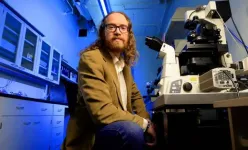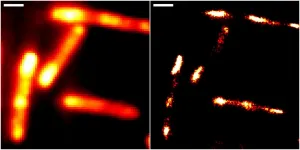(Press-News.org) Glycomics researchers at the University of Alberta and CHU Sainte-Justine have reported a discovery that could lead to new treatments for cardiovascular disease.
The researchers identified a new mechanism responsible for the buildup of plaque on artery walls, a process known as atherosclerosis. This plaque, made up of fats, cholesterol and other substances, can restrict blood flow and is a major factor in cardiovascular disease.
"We identified a new mechanism underlying atherosclerosis," explained Chris Cairo, professor in the Department of Chemistry and co-lead author of the new study. "We also demonstrated that this can be addressed pharmacologically. Using inhibitors developed in our lab, we found that this could be a new strategy for therapeutics in cardiovascular disease."
The discovery identified drug targets with the potential to stop the buildup of plaques--a breakthrough that could make a world of difference for many Canadians. The second leading cause of death in Canada, cardiovascular disease affects 2.4 million people across the nation, according to the federal government. New and more effective treatments are still needed, Cairo explained.
"The clinical implications of this study include the discovery of a novel pathway involved in the development of atherosclerosis--one of the most important causes of cardiovascular mortality--and the identification of novel, potentially druggable targets that can prevent atherosclerosis independent of cholesterol levels," said co-lead author Alexey Pshezhetsky from CHU Sainte-Justine.
The researchers examined the role of glycosylation of circulating lipid particles in the blood in atherosclerosis. Low-density lipoproteins (LDL), which are sometimes called bad cholesterol, are a complex of lipids, cholesterol and glycoproteins. The researchers looked at LDL particles before and after removal of a specific glycan residue, known as sialic acid. LDL that had sialic acids removed were taken up by cells more than those that were unmodified. Animal models deficient in the enzymes that remove sialic acids had less formation of atherosclerotic plaques, suggesting these enzymes could be new targets for future therapy.
"The work built on several years of basic research, and we hope will lead to benefits for clinical treatment," said Cairo, who noted the study was performed in animal models and will need more preclinical research before being applied in human clinical trials.
Cairo and Pshezhetsky are both network investigators with GlycoNet, a pan-Canadian Network Centre of Excellence of more than 170 glycomics researchers, centred at the U of A.
This research was funded by GlycoNet and conducted in collaboration with a post-doctoral fellow, Tianlin Guo, and a graduate student, Radhika Chakraberty, working at the U of A.
"It was exciting to see that this project is proceeding to the next phase, which is one step closer to clinical application," said Warren Wakarchuk, professor in the Department of Biological Sciences and scientific director of GlycoNet. "As a leader in glycomics research, GlycoNet is proud to be supporting the development of health innovations that will improve the quality of life of patients and their families in Canada and worldwide."
INFORMATION:
The study, "Neuraminidases 1 and 3 trigger atherosclerosis by desialylating low-density lipoproteins and increasing their uptake by macrophages," was published in the Journal of the American Heart Association.
Key takeaways
Opioid prescribing guideline is unique, taking into account each patient's perception of pain, rather than prescribing opioids based on type of operation.
Surgeons play a pivotal role in minimizing opioid use in their patients by setting expectations for pain management.
Opioid disposal rates dramatically increased because surgeons told patients about specific FDA-compliant methods for pill disposal, the location of a convenient pharmacy drop box, and made a reminder phone call.
CHICAGO (February 25, 2021): A prescribing guideline tailored to patients' specific needs reduced the number of opioid pills prescribed after major surgery with researchers reporting ...
Spring snowmelt in the Alps is occurring earlier in the year due to climate change and as a result triggering abrupt deviations in mountain ecosystems. These changes could negatively affect the functioning of these valuable ecosystems.
New research has demonstrated that vitally important microbial communities within Alpine soils are under threat as a direct result of increasing global temperatures caused by ongoing climate change. These belowground microbes critically support aboveground life because they recycle the key nutrients upon which all animals and plants depend, ...
Smartphones could be used to scan people's eyes for early-warning signs of glaucoma - helping to prevent severe ocular diseases and blindness, a new study reveals.
Some of the most common eye-related diseases are avoidable and display strong risk factors before onset, but it is much harder to pinpoint a group of people at risk from glaucoma.
Glaucoma is associated with elevated levels of intraocular pressure (IOP) and an accurate, non-invasive way of monitoring an individual's IOP over an extended period would help to significantly increase their chances of maintaining their vision.
Soundwaves used as a mobile measurement method would detect increasing values of ...
A safe, fast and cheap testing method that uses magnetic nanoparticles to detect viruses in both clinical and wastewater samples has been developed by KAUST researchers. The centrifuge-free approach is compatible with magnetic bead-based automated systems that are already used to process hundreds of samples.
"Our silica magnetic nanoparticle-based workflow can be assembled from scratch by any researcher," says lead author Gerardo Ramos-Mandujano. "It rivals commercial viral-RNA extraction kits while lowering the risk of handling potentially infectious samples."
To diagnose COVID-19, clinicians extract SARS-CoV-2 viral RNA from different types of clinical samples, such as nasopharyngeal swabs, and detect the virus using ...
Air pollution from fuel combustion is one of the greatest environmental problems, especially in urban environments. In densely populated cities, the presence of nitrogen oxides, very small carbon particles, and carbon monoxide (CO) in the air seriously harms the human health and increases mortality. A collaboration between researchers from the University of Barcelona and from the Boreskov Institute of Catalysis of the Russian Academy of Sciences in Novosibirsk (Russia) opens the way for reducing emissions of automotive pollutants. In a recent study, the scientists ...
Ribonucleic acid (RNA) is key to various fundamental biological processes. It transfers genetic information, translates it into proteins or supports gene regulation. To achieve a more detailed understanding of the precise functions it performs, researchers based at Heidelberg University and at the Karlsruhe Institute of Technology (KIT) have devised a new fluorescence imaging method which enables live-cell RNA imaging with unprecedented resolution.
The method is based on a novel molecular marker called Rhodamine-Binding Aptamer for Super-Resolution Imaging Techniques (RhoBAST). This RNA-based fluorescence marker is used in combination with the dye rhodamine. Due to their distinctive properties, marker and dye interact in a very specific way, which makes individual RNA molecules ...
Similar to the fact that a person would act differently when being alone, materials can also obtain unique qualities when being separated in atom-level, among which is the enhanced catalyzing ability.
Single-atom catalysts have shown enormous catalyzing capability since its first appearance. By preparing 2-dimensional (2D) single-atom monolayer crystals, scientists can expect to get catalysts with high loading density of active sites as well as great stability. However, the question herein is that only the edge atoms in the 2D monolayer have shown this effect while most of the atoms are inside the basal plane, which is critically limiting the efficiency ...
One of the main culprits of global warming is the vast amount of carbon dioxide pumped out into the atmosphere mostly from burning fossil fuels and the production of steel and cement. In response, scientists have been trying out a process that can sequester waste carbon dioxide, transporting it into a storage site, and then depositing it at a place where it cannot enter the atmosphere.
The problem is that capturing carbon from power plants and industrial emissions isn't very cost-effective. The main reason is that waste carbon dioxide isn't emitted pure, but is mixed with nitrogen and other gases, and extracting it from industrial emissions ...
NUI Galway study finds problem and non-problem gamblers differ in the gratifications they seek from mobile gambling
Non problematic mobile gambling is associated with positive mood
Advice for regulators and mobile gamblers on how to avoid gambling harms
A study carried out by the J.E. Cairnes School of Business and Economics at NUI Galway has examined how the different gratifications sought from mobile gambling explain problematic versus non-problematic patterns in highly involved gamblers.
For a subgroup of vulnerable individuals, gambling involvement can be pathological and reflects a personality disorder. ...
Previous research from the Norwegian University of Science and Technology (NTNU) has shown that people with anxiety disorders can benefit from two types of therapy. But in a new NTNU study, the same patients also exhibited major changes on a scientific personality test.
The treatment resulted in patients scoring lower on the neuroticism personality trait, and thereby perhaps having a lower risk of relapse. In general, the patients' personality profiles also normalized.
"Our findings might apply to treatment in general. The risk of relapse could be less if we manage to reduce patients' neuroticism," says Professor Leif Edward Ottesen Kennair at NTNU's Department of Psychology.
Two effective methods
People ...





